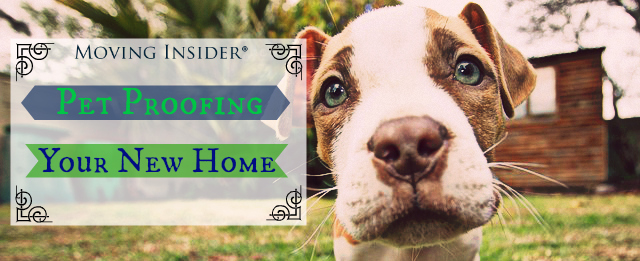The joys of having unpacked all of your belongings from the moving truck is a cause for celebration. But, before settling into your new home, make sure to carefully take the final step in completing your move: Pet proofing your new home. Your pet will need to adjust into the new home and by safely securing your house you will both be able to relax.
Get On Their Level 
Drop to your knees and hands and walk on your pet’s level. Getting down to their point of view will give you a different perspective as to what your pet sees and can get a hold of. Cords, connections, wires, loose strings from curtains, and any other string-like material should be moved to a higher level that won’t create any hazard for both your pet and your belongings. Animals are adventurous creatures and will look for new places to explore. Make sure to look for any dark openings (under couches, behind tables, etc.) that your pet can sneak into. Make sure to push your furniture to the wall and close any of the openings to avoid having your pet sneak into these dark and cooler areas.
Use Baby Materials
Cats and dogs alike are curious (list most animals) and will try to venture into your cabinets, drawers, closets and other areas that have doors. Invest in child-proof locks and baby gates to better block them from getting into medicine cabinets, cleaning supplies, bathrooms (the toilet, sink and shower may look like a giant water bowl to them), pantries, windows, and closets (shoes and clothes can be chewed up). If you’re just getting started, try re-purposing your moving boxes into gates while you find the right sized gate. Make sure to lock all buttons or doors that have a dangerous function. For example, the garbage disposal or garbage shoot.
 Invest In Furniture Repellent
Invest In Furniture Repellent
Pets will not only see couches, tables, pillows, beds and all other furniture as sleeping areas, but also as their personal scratch and chew toys. By researching for the best furniture repellents you’ll find a healthy dose of natural and non-harmful sprays you can use that will not hurt your pet or your belongings. Try allocating a specific room just for your pet when you move in so that you can keep all accidental urges and pet messes (from chewed up toys to potty meltdowns) to one concentrated area. Create a pet zone in your home where your cat or dog can safely sleep, play, eat and enjoy their personal space.
Hide Your Fancy/Expensive Decorations
Remember that heirloom you inherited from your great-great-grandmother? Or that expensive wedding gift your aunt purchased? Living with pets is like living with children. They’ll want to touch, sniff, chew and play with everything. Price doesn’t matter to them. Make sure to hide all of your expensive items (or those with sentimental meaning) out of your pet’s sight and reach. Place them in higher locations (while keeping in mind that dogs and cats can normally jump at least twice their size).
Safety First
Food, drinks, cleaning supplies, medications, lotions, wrappers, trash cans, laundry supplies, office supplies, knick-knacks, plants, craft and sewing supplies, cosmetics, and electronics all pose a hazard to your pet. Think logically and creatively when pet-proofing your new home. Animals are curious, and moving into a new home will take them out of their normal surroundings; they’ll want to explore. Give your pets toys, snacks, food and playtime to keep them busy, happy and (eventually) sleepy.
How was your experience with pet-proofing a new home? Do you have any tips for other pet owners? Let us know in the comments below!




